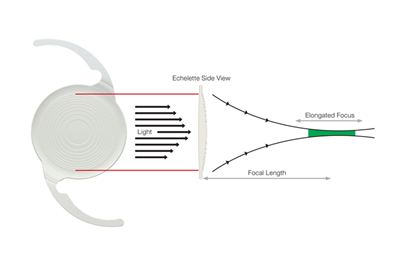Extended depth of focus IOLs (EDOF-IOLs), also known as extended range of vision IOLs (ERV-IOLs), are a new type of intraocular lens that use an entirely new design concept to allow for an extended range of crisp vision with a high rate of spectacle independence. This is accompanied by a low incidence of photic phenomena, such as halos and glare.
Minimal focus on presbyopia-correcting implants
Even though more than 3.6 million cataract surgery procedures are performed annually in the United States, according to the Market Scope Q4-2014 Survey of US Cataract Surgeons, only 4.6% involve presbyopia-correcting implants. Whether multifocal or accommodative, both options have their limitations.
Consequently, many ophthalmologists shy away from these choices and offer mini-mono vision where the dominant eye is usually targeted for distance and the nondominant eye for the intermediate/near range, with a planned diopteric IOL power difference between eyes.
Extending the range of vision
The Tecnis Symfony Extended Range of Vision IOL (Abbott Medical Optics), available in toric and nontoric versions, is indicated to provide a full range of continuous, high-quality vision without some of the limitations of multifocal IOLs. Although this new implant (Figure 1) looks like a diffractive multifocal optic, its unique design is intended to deliver well-focused vision over an enhanced range, along with 50% less light loss than a traditional diffractive implant model. The optic design also corrects for chromatic aberration for added clarity. The defocus curve established in clinical trials thus far shows ample uncorrected intermediate vision, in addition to clear distance and functional near visual acuities.

Figure 1: Schematic of Tecnis Symfony Extended Range of Vision IOL.
This IOL became available in Europe last year. Enrollment has closed in a U.S. FDA study of the IOL, and the results are expected to be monitored during the second quarter of 2015.
Extending the depth of focus
Hoya Surgical Optics has been developing EDOF implants but they are not yet available in the United States.
The Softec HD IOL from Lenstec has some properties that make it similar to EDOF lenses. Because the Softec HD IOL is made with a hydrophilic acrylic material, it is more pliable than hydrophobic acrylic IOLs and may provide some intermediate vision. Moreover, the zero spherical aberration of this implant when coupled with the cornea’s natural positive spherical aberration may give an overall positive spherical aberration for extended depth of focus with functional intermediate vision.
Premium or New Technology designation possible
According to Donna McCune, vice president of Corcoran Consulting Group, these EDOF and ERV IOLs may fall into a new class of premium channel or New Technology IOLs (NTIOLs) as designated by the FDA.
Currently, only presbyopia- and astigmatism-correcting IOLs are designated as premium implants by the Centers for Medicare and Medicaid Services. However, there are no active NTIOLs, as the NTIOL status of previous products has expired.
If EDOF or ERV IOLs receive New Technology IOL (NTIOL) designations, then an out-of-pocket charge paid by patients may be possible. Additional information on the process can be found here.
While no one can say with certainty what may happen with this new category of lenses, EDOF or ERV IOLs may become available in the United States in the not-too-distant future.
Financial Disclosures: Cynthia Matossian, MD, is a speaker/consultant for Abbott Medical Optics and a speaker for LensTec. She has no financial relationship with Hoya. She can be reached at cmatossian@matossianeye.com